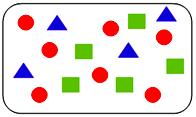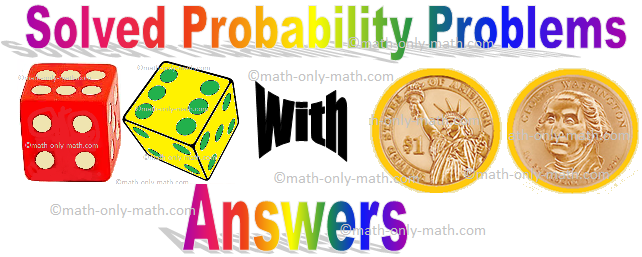Subscribe to our ▶️ YouTube channel 🔴 for the latest videos, updates, and tips.
Solved Probability Problems
Solved probability problems and solutions are given here for a concept with clear understanding.
Students can get a fair idea on the probability questions which are provided with the detailed step-by-step answers to every question.
Solved probability problems with solutions:
1.

The graphic above shows a container with 4 blue triangles, 5 green squares and 7 red circles. A single object is drawn at random from the container.
Match the following events with the corresponding probabilities:
|
(i) The objects is not a circle (ii) The objects is a triangle (iii) The objects is not a triangle (iv) The objects is not a square (v) The objects is a circle (vi) The objects is a square |
(a) 5/16 (b) 4/16 (c) 7/16 (d) 9/16 (e) 12/16 (f) 11/16 |
Solution:
Number of blue triangles in a container = 4
Number of green squares = 5
Number of red circles = 7
Total number of objects = 4 + 5 + 7 = 16
(i) The objects is not a circle:
P(the object is a circle)
= Number of circles/Total number of objects
= 7/16
P(the object is not a circle)
= 1 - P(the object is a circle)
= 1 - 7/16
= (16 - 7)/16
= 9/16
(ii) The objects is a triangle:
P(the object is a triangle)
= Number of triangle/Total number of objects
= 4/16
(iii) The objects is not a triangle:
P(the object is a triangle)
= Number of triangles/Total number of objects
= 4/16
P(the object is not a triangle)
= 1 - P(the object is a triangle)
= 1 - 4/16
= (16 - 4)/16
= 12/16
(iv) The objects is not a square:
P(the object is a square)
= Number of squares/Total number of objects
= 5/16
P(the object is not a square)
= 1 - P(the object is a square)
= 1 - 5/16
= (16 - 5)/16
= 11/16
(v) The objects is a circle:
P(the object is a circle)
= Number of circles/Total number of objects
= 7/16
(vi) The objects is a square:
P(the object is a square)
= Number of squares/Total number of objects
= 5/16
Match the following events with the corresponding probabilities are shown below:
|
(i) The objects is not a circle (ii) The objects is a triangle (iii) The objects is not a triangle (iv) The objects is not a square (v) The objects is a circle (vi) The objects is a square |
(d) 9/16 (b) 4/16 (e) 12/16 (f) 11/16 (c) 7/16 (a) 5/16 |
2. A single card is drawn at random from a standard deck of 52 playing cards.
Match each event with its probability.
Note: fractional probabilities have been reduced to lowest terms. Consider the ace as the highest card.
|
(i) The card is a diamond (ii) The card is a red
king (iii) The card is a king or queen (iv) The card is either a red or an ace (v) The card is not a king (vi) The card is a five or lower (vii) The card is a king (viii) The card is black |
(a) 1/2 (b) 1/13 (c) 1/26 (d) 12/13 (e) 2/13 (f) 1/4 (g) 4/13 (h) 7/13 |
Solution:
Total number of playing cards = 52
(i) The card is a diamond:
Number of diamonds in a deck of 52 cards = 13
P(the card is a diamond)
= Number of diamonds/Total number of playing cards
= 13/52
= 1/4
(ii) The card is a red king:
Number of red king in a deck of 52 cards = 2
P(the card is a red king)
= Number of red kings/Total number of playing cards
= 2/52
= 1/26
(iii) The card is a king or queen:
Number of kings in a deck of 52 cards = 4
Number of queens in a deck of 52 cards = 4
Total number of king or queen in a deck of 52 cards = 4 + 4 = 8
P(the card is a king or queen)
= Number of king or queen/Total number of playing cards
= 8/52
= 2/13
(iv) The card is either a red card or an ace:
Total number of red card or an ace in a deck of 52 cards = 28
P(the card is either a red card or an ace)
= Number of cards which is either a red card or an ace/Total number of playing cards
= 28/52
= 7/13
(v) The card is not a king:
Number of kings in a deck of 52 cards = 4
P(the card is a king)
= Number of kings/Total number of playing cards
= 4/52
= 1/13
P(the card is not a king)
= 1 - P(the card is a king)
= 1 - 1/13
= (13 - 1)/13
= 12/13
(vi) The card is a five or lower:
Number of cards is a five or lower = 16
P(the card is a five or lower)
= Number of card is a five or lower/Total number of playing cards
= 16/52
= 4/13
(vii) The card is a king:
Number of kings in a deck of 52 cards = 4
P(the card is a king)
= Number of kings/Total number of playing cards
= 4/52
= 1/13
(viii) The card is black:
Number of black cards in a deck of 52 cards = 26
P(the card is black)
= Number of black cards/Total number of playing cards
= 26/52
= 1/2
Match the following events with the corresponding probabilities are shown below:
|
(i) The card is a diamond (ii) The card is a red
king
(iii) The card is a king or queen (iv) The card is either a red or an ace (v) The card is not a king (vi) The card is a five or lower (vii) The card is a king |
(f) 1/4 (c) 1/26 (e) 2/13 (h) 7/13
(d) 12/13 (g) 4/13 (b) 1/13 (a) 1/2 |
3. A bag contains 3 red balls and 4 black balls. A ball is drawn at random from the bag. Find the probability that the ball drawn is
(i) black
(ii) not black.
Solution:
(i) Total number of possible outcomes = 3 + 4 = 7.
Number of favourable outcomes for the event E.
= Number of black balls = 4.
So, P(E) = \(\frac{\textrm{Number of Favourable Outcomes for the Event E}}{\textrm{Total Number of Possible Outcomes}}\)
= \(\frac{4}{7}\).
(ii) The event of the ball being not black = \(\bar{E}\).
Hence, required probability = P(\(\bar{E}\))
= 1 - P(E)
= 1 - \(\frac{4}{7}\)
= \(\frac{3}{7}\).
4. If the probability of Serena Williams a particular tennis match is 0.86, what is the probability of her losing the match?
Solution:
Let E = the event of Serena Williams winning.
From the question, P(E) = 0.86.
Clearly, \(\bar{E}\) = the event of Serena Williams losing.
So, P(\(\bar{E}\)) = 1 - P(E)
= 1 - 0.86
= 0.14
= \(\frac{14}{100}\)
= \(\frac{7}{50}\).
5. Find the probability of getting 53 Sunday in a leap year.
Solution:
A leap year has 366 days. So, it has 52 weeks and 2 days.
So, 52 Sundays are assured. For 53 Sundays, one of the two remaining days must be a Sunday.
For the remaining 2 days we can have
(Sunday, Monday), (Monday, Tuesday), (Tuesday, Wednesday), (Wednesday, Thursday), (Thursday, Friday), (Friday, Saturday), (Saturday, Sunday).
So, total number of possible outcomes = 7.
Number of favourable outcomes for the event E = 2, [namely, (Sunday, Monday), (Saturday, Sunday)].
So, by definition: P(E) = \(\frac{2}{7}\).
6. A lot of 24 bulbs contains 25% defective bulbs. A bulb is drawn at random from the lot. It is found to be not defective and it is not put back. Now, one bulb is drawn at random from the rest. What is the probability that this bulb is not defective?
Solution:
25% of 24 = \(\frac{25}{100}\) × 24 = 6.
So, there are 6 defective bulbs and 18 bulbs are not defective.
After the first draw, the lot is left with 6 defective bulbs and 17 non-defective bulbs.
So, when the second bulb is drwn, the total number of possible outcomes = 23 (= 6+ 17).
Number of favourable outcomes for the event E = number of non-defective bulbs = 17.
So, the required probability = P(E) = (\frac{17}{23}\).
The examples can help the students to practice more questions on probability by following the concept provided in the solved probability problems.
Probability
Probability of Tossing Two Coins
Probability of Tossing Three Coins
Probability for Rolling Two Dice
Probability for Rolling Three Dice
From Solved Probability Problems to HOME PAGE
Didn't find what you were looking for? Or want to know more information about Math Only Math. Use this Google Search to find what you need.



New! Comments
Have your say about what you just read! Leave me a comment in the box below. Ask a Question or Answer a Question.